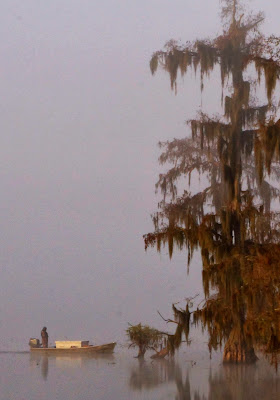Terminology is an issue here. We got our first lesson at the
Evangeline - Longfellow Historical Site State Park in St. Martinville, LA. Some of the terms that get bandied around here to describe the culture, the people and the geography can get complicated, and confusing. Much of the terminology is based on the French language, which we have little or no experience with, so we are dependent on others (and the internet) for translation.
I referred to this area as "Cajun Country" in my last post. Today I'm calling it bayou country, because bayou means river and the wide spread wetlands that the rivers create in this flat geography. Bayou does not refer to the people or culture, though it is associated with both, because on the bayou is where many people live around here. But not all Acadians (Cajuns) or Creoles live on the bayou.
We started hearing the terms Cajun, Acadian and Creole to describe the people in New Orleans, and were beginning to get a handle on it. One of the knowledgable guides at the State Park helped us out, and the exhibit in the museum was even more helpful. Below is the Olivier Mansion, or Maison Olivier, the home around which this park was constructed. It was originally thought to be an Acadian home, but later research determined it was Creole. Confusion doesn't seem to be confined to out-of-towners.

Our first guide, below, explained that the Creoles were the descendants of the French people who began settling this colonial territory before our Relolutionary war. Because other peoples, including Spanish, West Indian, African and Native American also lived here before, during and after that period, Creole describes a complex combination of cultures, but seems to refer to the people who were originally here before the Acadians arrived. There also seems to be a more subtle difference between these peoples based on class, which isn't talked about as easily, as elements of and feelings about these differences seem to still remain.
Many of the Creoles were quite wealthy and owned plantations in the area. This is one of those plantations or substantial farms, with slaves. Around here the staple crop was, and still is sugar cane. Because of the heat, humidity and flooding, the homes are often built up off the ground, and have large shaded porches and storage areas on the ground level.
Now,
Acadians are the French people who emigrated to Louisiana from the Nova Scotia area of Canada. They were forcefully evicted from their homeland by the British, a story that was retold in Longfellows fictional narrative poem,
Evangeline. The poem brought the Acadian story to the attention of people all over the country, and probably the world, who had no idea who the Acadians were. The state park originated as an effort to preserve the cultural heritage of the Acadians, as inspired by
Evangeline.

The descendants of those Acadians are now referred to as Cajuns, a word derived directly from the pronunciation of Acadian. Our second guide (above) at the state park told us about the lives of the Acadians/Cajuns who lived more simply, as illustrated by the farm buildings in this part of the park. The first is a simple cabin. This "farm" was in close proximity to a coulee, or small waterway by which they accessed the Bayou Teche, a major river in the area.
Other buildings include barns, kitchens, and other out buildings for various purposes.
There were several gardens for the family's personal use. The Acadians didn't grow fruits or vegetables for a cash crop, but they did raise cattle, trap animals and fish for trade or sale as well as for family use.
The Evangeline - Longfellow State Park is in the historic town of
St. Martinville, considered the heart or birthplace of Cajun culture. Below is the historic Catholic church of St. Martin de Tours, built in 1836.
We lunched at
Victor's Cafeteria in nearby New Iberia with a very reasonably priced homestyle meal that included the best green beans I've ever had. Then we drove further south to Avery Island, home of
McIlhenny's Tabasco hot sauce. We visited the bottling plant...
...and the gift shop, and received lots of little free samples.
Avery Island is one of three large salt mounds near the Gulf shore, amidst otherwise very low land. The original McIlhenny bought the island, set up his Tobasco sauce business, which still includes fields of peppers and a salt mine. He also established
Jungle Gardens - an arboretum through which you can walk or drive. It has several ponds and a river running through it, complete with alligators. One of its claims to fame is "Bird City,"a protected nesting area for herons that contributed to the preservation of the species that was practically wiped out for their feathers. Neither alligator nor herons were around the day we visited; not the right season.

This one day of excursions and the education they've already offered have gotten me thinking so much about culture, and how "outsiders" gain access to it. As tourists, we are offered places to go and things to do right off the highway. But beyond that, it takes some time, work and patience to find the "real" culture - the people, the food, the music, the homes and farms, the grocery stores and barber shops. We're finding our way, as we have in other places, and taking our time. We'll let you know what and who we encounter as we go.




















































